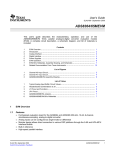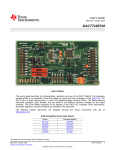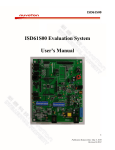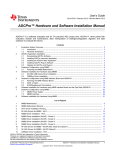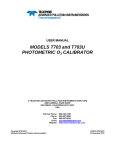Download ADS8568EVM-PDK User Guide (Rev. A)
Transcript
User's Guide SBAU193A – July 2011 – Revised February 2012 ADS8568EVM-PDK Figure 1. ADS8568EVM-PDK This user's guide describes the characteristics, operation, and use of the ADS8568EVM by itself and as part of the ADS8568EVM-PDK. This evaluation module (EVM) is an evaluation platform for the ADS8568, a 16-bit, eight-channel, simultaneous sampling, bipolar input analog-to-digital converter (ADC). The ADS8568EVM allows evaluation of all aspects of the ADS8568 device. This document includes an EVM QuickStart, hardware and software details, bill of materials, and schematic. ADCPro is a trademark of Texas Instruments Incorporated. All other trademarks are the property of their respective owners. SBAU193A – July 2011 – Revised February 2012 Submit Documentation Feedback Copyright © 2011–2012, Texas Instruments Incorporated ADS8568EVM-PDK 1 www.ti.com 1 2 3 4 5 6 Contents EVM Overview ............................................................................................................... 3 QuickStart .................................................................................................................... 4 Quick Reference ............................................................................................................ 6 Using the ADS8568EVM-PDK Plug-In in ADCPro ..................................................................... 7 ADS8568EVM Hardware Details ........................................................................................ 10 Bill of Materials, Layout, and Schematic ............................................................................... 14 1 ADS8568EVM-PDK ......................................................................................................... 1 2 ADS8568EVM Default Jumper Settings 3 Operation in Hardware Mode .............................................................................................. 8 4 Operation in Software Mode ............................................................................................... 9 5 Analog Input Schematic 6 Jumpers JP16, JP18, JP21, and JP22 ................................................................................. 11 7 BVDD Voltage Selection 8 ADS8568EVM: Silkscreen (Top Layer) ................................................................................. 17 9 ADS8568EVM: Top 10 ADS8568EVM: Internal GND Layer 1 .................................................................................. 17 11 ADS8568EVM: Internal Layer 2 ......................................................................................... 17 12 ADS8568EVM: Silkscreen (Bottom Layer) ............................................................................. 17 13 ADS85x8EVM: Schematic 1 ............................................................................................. 19 14 ADS85x8EVM: Schematic 2 ............................................................................................. 20 List of Figures ................................................................................. .................................................................................................. ................................................................................................... ....................................................................................................... 4 10 13 17 List of Tables 1 Related Documents ......................................................................................................... 3 2 Default Jumper Configuration ............................................................................................. 5 3 Connector J3: Power-Supply Inputs 12 4 Analog Bipolar Input Supply Jumpers 12 5 6 7 2 .................................................................................... .................................................................................. Connector J4: Parallel Control ........................................................................................... Connector J5: Parallel Interface Data Ouput .......................................................................... Bill of Materials............................................................................................................. ADS8568EVM-PDK 14 14 15 SBAU193A – July 2011 – Revised February 2012 Submit Documentation Feedback Copyright © 2011–2012, Texas Instruments Incorporated EVM Overview www.ti.com 1 EVM Overview The ADS8568EVM is an evaluation module (EVM) built to the TI Modular EVM System specification. It can be connected to any of the modular EVM system interface cards available from Texas Instruments. The ADS8568EVM is available as a stand-alone printed circuit board (PCB) or as part of the ADS8568EVM-PDK, which includes an MMB1 motherboard and software. As a stand-alone PCB, the ADS8568EVM is useful for prototyping designs and firmware. 1.1 ADS8568EVM Features • • • • Contains all support circuitry needed for the ADS8568 Voltage reference options: internal reference, onboard REF5025, or external reference Analog input bipolar voltage supply options: onboard ±14.5 V HV analog supplies or external supply inputs Compatible with the TI Modular EVM System The ADS8568EVM-PDK includes the ADS8568EVM and an Opal Kelly XEM3010-based MMB1 motherboard that can be used with ADCPro™ to quickly evaluate the device. This manual covers the operation of the ADS8568 device referred to as the ADS8568EVM and the ADS8568EVM-PDK. Throughout this document, the abbreviation EVM and the term evaluation module are synonymous with the ADS8568EVM. 1.2 Related Documentation from Texas Instruments The related documents listed in Table 1 are available for download through the Texas Instruments web site at www.ti.com. Table 1. Related Documents Device Literature Number ADS8568 SBAS543 OPA2211 SBOS377 TPS65131 SLVS493 REF5025 SBOS410 SN74LVC1G17D SCES351 SBAU193A – July 2011 – Revised February 2012 Submit Documentation Feedback Copyright © 2011–2012, Texas Instruments Incorporated ADS8568EVM-PDK 3 QuickStart 2 www.ti.com QuickStart This section provides a QuickStart guide to quickly get up and running using ADCPro. 2.1 Default Jumper Settings A silkscreen detailing the default jumper settings is shown in Figure 2. Table 2 explains the configuration for these jumpers. Figure 2. ADS8568EVM Default Jumper Settings 4 ADS8568EVM-PDK SBAU193A – July 2011 – Revised February 2012 Submit Documentation Feedback Copyright © 2011–2012, Texas Instruments Incorporated QuickStart www.ti.com Table 2. Default Jumper Configuration 2.2 Pin Number Default Position JP1 Short 2-3 Selects the buffered A0 input configuration JP2 Short 2-3 Selects the buffered A1 input configuration Switch Description JP3 Open JP4 Short 1-2 Sets CS low with R17 Selects +5 VD as the BVDD voltage JP5 Short 2-3 Selects the buffered C0 input configuration JP6 Short 2-3 Selects the buffered B0 input configuration JP7 Short 2-3 Selects the buffered B1 input configuration JP8 Short 2-3 Selects the buffered C1 input configuration JP9 Short 1-2, 4-5, 7-8, and 10-11 JP10 Short 1-2 Selects +HVINT for the +VOP AMP supply JP11 Short 1-2 Selects –HVINT for the –VOP AMP supply JP12 Open External reference not connected to REFIO JP13 Short 2-3 Selects the buffered D0 input configuration JP14 Short 2-3 Selects the buffered D1 input configuration JP15 Open JP16 Closed Conversion start to J4.17 DCTOUT Disables auto-sleep mode Selects hardware mode JP17 Open JP18 Short 2-3 Disables RESET Selects the ±4 VREF range JP19 Short 1-2 Selects +HVINT for the +HVDD ADC supply JP20 Short 1-2 Selects –HVINT for the –HVSS ADC supply JP21 Open Internal ADC reference enabled JP22 Closed Selects parallel interface mode JP23 Short 1-2 ±HVINT (±14 V) onboard supply on ADS8568EVM-PDK Kit Operation To prepare to evaluate the ADS8568 with the ADS8568EVM-PDK, complete the following steps: 1. Verify the jumpers on the ADS8568EVM are as shown in Figure 2 (note that these settings are the factory-configured settings for the EVM). 2. Using the MMB1 Motherboard User's Guide (SLAU372), verify the MMB1 jumpers are in the default position and install the ADCPro and ADS8568EVM plug-in software. Complete hardware connections and driver installation as part of the MMB1 Motherboard User's Guide (SLAU372). 3. Plug the ADS8568EVM into the MMB1. The female portion of J2, J3, J4, and J5 on the EVM align with the respective male connectors J6, J7, J13, and J14 of the MMB1. 4. Connect the included ac adapter to the MMB1. CAUTION Do not misalign the pins when plugging the ADS8568EVM into the MMB1. Check the pin alignment of J2, J3, J4, and J5 carefully before applying power to the ADS8568EVM-PDK. SBAU193A – July 2011 – Revised February 2012 Submit Documentation Feedback Copyright © 2011–2012, Texas Instruments Incorporated ADS8568EVM-PDK 5 Quick Reference www.ti.com 3 Quick Reference 3.1 Analog Input Eight of the analog input sources (channels 0 to 7) can be applied directly to header J2 of the ADS8568EVM (top side) or through the analog IO J3 connector on the MMB1 board. Each analog input signal can be configured to connect to the ADS8568 through the OPA2211 inverting, unity-gain buffers (default condition JPx jumpered pins 2 to 3) or directly to the ADS8568 device. Refer to the Analog Input Circuit section of the ADS8568EVM Hardware Details for more information about the analog input circuit. By default, the device is set up with the 2.5-V internal reference and the ±4x VREF range selected; corresponding to ±10-V range. 3.2 Digital Control There is a variety of control lines associated with the ADS8568EVM that are user-accessible through various jumpers. The ADS8568 may output the conversion results using a serial or parallel interface. The ADS8568EVM may be set in parallel or serial mode through jumper JP22 and may be configured in hardware or software control mode through jumper JP16. The operating mode of the device determines which connector pins on connectors J4 and J5 are used to control the converter operation and timing, and which pins on the connector output the digital results. NOTE: 3.3 The ADS8568EVM-PDK kit with ADCPro supports the parallel interface mode of operation under hardware mode or software mode control. By factory default, the ADS8568EVM-PDK is configured to operate with the parallel interface (JP22 shunt) under hardware control (JP16 shunt). When using the ADS8568EVM-PDK kit, the parallel interface conversion results are available through connector J5. Power Supply The analog portion of the ADS8568 requires an analog 5-V supply and a bipolar input supply. The 5-V analog voltage supply can be generated by the ac adapter or by applying the +5 VA to the connector of the MMB1 board. The ADS8568EVM is configured at the factory with the onboard ±14.5-V bipolar supply. The user can also select to apply the bipolar supply to the ±VA connectors on the MMB1 board. Please refer to the Power Supplies section of the ADS8568EVM Hardware Details for more information. CAUTION Do not exceed the ±18-VDC bipolar Input supply limit. Damage to the op amps and the ADS8568 can occur if this limit is exceeded. 3.4 Voltage Reference The ADS8568 has an internal, 2.5-V to 3-V programmable reference. Alternatively, the user can select the onboard 2.5-V reference, REF5025 (U7). The device is set up by default in hardware mode (JP16 closed) with the internal 2.5-V reference enabled (JP21 open). Refer to the ADS8568 Internal Reference and EVM Onboard Reference section of the ADS8568EVM Hardware Details for more information. CAUTION If the REF5025 2.5-V onboard reference is required, the internal reference must be disabled by first shorting JP21 and afterwards installing JP12. Ensure JP12 is open whenever the internal reference is enabled to avoid potential damage to the ADS8568 device. 6 ADS8568EVM-PDK SBAU193A – July 2011 – Revised February 2012 Submit Documentation Feedback Copyright © 2011–2012, Texas Instruments Incorporated Using the ADS8568EVM-PDK Plug-In in ADCPro www.ti.com 4 Using the ADS8568EVM-PDK Plug-In in ADCPro 4.1 Using the ADS8568EVM-PDK Plug-in The ADS8568EVM-PDK plug-in for ADCPro provides control over all settings of the ADS8568 in parallel interface mode. The ADS8568EVM-PDK plug-in may be used in Hardware mode or Software mode. The user can adjust the ADS8568EVM settings when not acquiring data. During acquisition, all controls are disabled and settings may not be changed. When a setting is changed on the ADS8568EVM plug-in, the setting immediately updates on the board. Settings on the ADS8568EVM correspond to settings described in the ADS8568 product data sheet. 4.1.1 Operation in Hardware Mode For proper operation in hardware mode, the user selects Hardware mode by clicking on the Mode panel. Jumper JP16 must be shunted or closed; refer to Figure 3. The channel range is adjusted in hardware mode by setting jumper JP18: shunt 2-3: ±4x VREF range is selected; shunt 1-2: ±2x VREF range is selected. For proper operation, the user must also ensure that the channel range in ADCPro matches the hardware settings. When using the internal reference, the user must verify that jumper JP12 is open; JP21 must be open to enable the internal reference. If the onboard REF5025 2.5-V reference is desired, JP21 must be shunted to disable the internal reference and the user must switch to Software mode. The user may input the desired sampling rate on the Data Rate panel. The data rate is limited by the ADS8568EVM plug-in software to a maximum of 400 kSPS. The conversion results are available on connector J5. SBAU193A – July 2011 – Revised February 2012 Submit Documentation Feedback Copyright © 2011–2012, Texas Instruments Incorporated ADS8568EVM-PDK 7 Using the ADS8568EVM-PDK Plug-In in ADCPro www.ti.com Figure 3. Operation in Hardware Mode 8 ADS8568EVM-PDK SBAU193A – July 2011 – Revised February 2012 Submit Documentation Feedback Copyright © 2011–2012, Texas Instruments Incorporated Using the ADS8568EVM-PDK Plug-In in ADCPro www.ti.com 4.1.2 Operation in Software Mode For proper operation in software mode, the user selects Software mode by clicking on the Mode panel. Jumper JP16 must be open, as shown in Figure 4. Figure 4. Operation in Software Mode When using the internal reference, the user must verify that jumper JP12 is open and select Internal in the Vref Source control. The Internal Reference Buffers must be enabled by selecting the appropriate panel. The user may choose either the 2.5 V or 3.0 V internal VREF. In addition, the user may program the VREF DAC to adjust the voltage reference by placing the code value (as determined by Equation 1) in the Vref DAC panel provided. VREF = Range × (Code + 1)/1024 (1) SBAU193A – July 2011 – Revised February 2012 Submit Documentation Feedback Copyright © 2011–2012, Texas Instruments Incorporated ADS8568EVM-PDK 9 ADS8568EVM Hardware Details www.ti.com Code is the decimal value of the DAC register content. To ensure proper performance, the DAC output voltage should not be programmed below 0.5 V. If the external reference is desired, the user must disable the internal reference first by selecting External. The user may either install jumper J12 to connect the onboard 2.5-V REF5025 reference or connect an external reference. The allowed external reference range is from 0.5 V to 3.025 V. The user must input the reference voltage in the External Vref Source panel provided in the screen in order for ADCPro to display the conversion results properly. When the device is operating in software mode, the channel range is adjusted for each channel pair by selecting either ±4x VREF or ±2x VREF in the Channel Input Range panel. Each device channel pair (except channel pair A, which is the master channel pair and is always active) can be individually switched off using the Powerdown panel provided. The user may input the desired sampling rate on the Data Rate panel. The data rate is limited by the ADS8568EVM plug-in software to a maximum of 400 kSPS. The conversion results are available on connector J5. 5 ADS8568EVM Hardware Details The ADS8568EVM is designed to easily interface with multiple control platforms. Dual-row, header/socket combinations at J2, J3, J4, and J5 allow connection to external circuitry for evaluation and debug. 5.1 Analog Input Circuit The circuit at the analog input of the ADS8568EVM board consists of four independent OPA2211 dual operational amplifiers. The OPA2211 dual op amps may be powered from an onboard ±14.5-V analog supply or from an external supply. The amplifiers are configured as inverting, unity-gain buffers by default. The OPA2211 buffer input circuit is shown in Figure 5. This circuit is used in all eight input channels. Jumper JPx can be used to bypass the input buffer circuit. Figure 5. Analog Input Schematic 10 ADS8568EVM-PDK SBAU193A – July 2011 – Revised February 2012 Submit Documentation Feedback Copyright © 2011–2012, Texas Instruments Incorporated ADS8568EVM Hardware Details www.ti.com 5.2 ADS8568 Internal Reference and EVM Onboard Reference The ADS8568 has an internal, programmable 2.5-V or 3-V internal reference. Alternatively, the user can select the onboard 2.5-V reference, REF5025 (U7). • When the device is set up in hardware mode (JP16 closed), the internal fixed 2.5-V reference is enabled through the REFEN pin (JP21 open). Refer to Figure 6 for the jumper location. The channel range is adjusted in hardware mode by the JP18 settings: – JP18 shunt 2-3: ±4x VREF range selected – JP18 shunt 1-2: ±2x VREF range selected NOTE: The device is configured at the factory in hardware mode with a 2.5-V reference and a ±4x VREF range. The Operation in Hardware Mode section provides more detailed information about the hardware mode of operation. • • When the device is set up in software mode (JP16 open), the user can select either the internal 2.5-V or 3.0-V programmable reference and choose either the ±4x VREF or ±2x VREF range through the software panel on the ADS8568EVM Plug-In. If the onboard REF5025 2.5-V reference is desired, the internal reference must first be disabled (in hardware mode, J21 must be shunted to disable the reference). The ADS8568EVM provides an onboard 2.5-V reference via U7. To use the REF5025 reference, a shunt jumper must be placed on JP12. Test points TP8 and TP9 are provided to allow the user to monitor the reference voltage (either internal or the REF5025) and may also be used to connect a user-provided reference voltage in the range of 0.5 V to 3.025 V. Figure 6. Jumpers JP16, JP18, JP21, and JP22 SBAU193A – July 2011 – Revised February 2012 Submit Documentation Feedback Copyright © 2011–2012, Texas Instruments Incorporated ADS8568EVM-PDK 11 ADS8568EVM Hardware Details 5.3 www.ti.com Power Supplies The ADS8568EVM-PDK is configured at the factory with an on-board bipolar analog input ±14.5 V switching supply (±HV), a +5-V AVDD analog supply, and either a +5 BVDD or +3.3 VDD supply. For ADS8568EVM stand-alone operation, power sources can be applied through connector J3 on the board. Table 3 shows the various supply connections on connector J3. Table 3. Connector J3: Power-Supply Inputs Signal 5.3.1 Pin Number Signal +VA Connects to HVDD 1 2 (+VA) Connects to HVSS (+5 VA) Connects to AVDD 3 4 Unused DGND 5 6 AGND Unused 7 8 Unused +3.3 V optional BVDD 9 10 +5 V optional BVDD Bipolar Analog Input Supplies The board is configured from the factory with a ±14.5-V switching supply to generate the HV analog bipolar input ±14.5-V supply. The onboard ±14.5 V is generated via the TPS65131 positive and negative dc to dc converter. The user could also provide power to the HV supplies and onboard buffers from a well-regulated, external linear supply that has current-limiting capabilities. The HVDD and HVSS supplies to the ADS8568 can be selected through jumpers JP19 and JP20. The supplies to the OPA2211 buffers can be selected through jumpers JP10 and JP11. If the user desires to use the external linear supply; the switching power supply may be disabled by placing jumper JP23 to the OFF position. Ensure all power is off before manipulating the power-supply jumpers. Table 4 describes the bipolar input supply jumpers. Table 4. Analog Bipolar Input Supply Jumpers Pin Number Default Position Switch Description JP10 Short 1-2 1-2 On-board +HVINT to OPA2211 buffers 2-3 External +HV supply to OPA2211buffers JP11 Short 1-2 1-2 On-board -HVINT to OPA2211 buffers 2-3 External -HV supply to OPA2211buffers JP19 Short 1-2 1-2 On-board +HVINT to HVDD supply on ADS8568 2-3 External +HV to HVDD supply on ADS8568 JP20 Short 1-2 1-2 On-board +HVINT to HVDD supply on ADS8568 2-3 External +HV to HVDD supply on ADS8568 CAUTION Do not exceed the ±18-VDC bipolar input supply limit. Damage to the op amps and the ADS8568 can occur if this limit is exceeded. 12 ADS8568EVM-PDK SBAU193A – July 2011 – Revised February 2012 Submit Documentation Feedback Copyright © 2011–2012, Texas Instruments Incorporated ADS8568EVM Hardware Details www.ti.com 5.3.2 Analog +5-V Supply The ADS8568EVM board requires an independent +5-V supply to power the analog portion of the DUT, the external reference, and the external reference buffer. This voltage is applied through J3 (pin 3) and is denoted as AVDD. This supply can be monitored at test point TP3. 5.3.3 Digital Power: Buffer I/O Supply The buffer I/O supply of the ADS8568EVM-PDK is provided through connector J3. Connector J3 has a +3.3-V and +5-V digital supply defined on pins 9 and 10, respectively. Jumper JP4 on the EVM allows the user to select the default +5.5 V or 3.3 V for the device BVDD source. This voltage is also applied to the remaining digital circuitry on the EVM. Figure 7 shows jumper JP4 configured for the 3.3-VD buffer I/O supply. Figure 7. BVDD Voltage Selection SBAU193A – July 2011 – Revised February 2012 Submit Documentation Feedback Copyright © 2011–2012, Texas Instruments Incorporated ADS8568EVM-PDK 13 Bill of Materials, Layout, and Schematic 5.4 www.ti.com Digital Controls: J4 and J5 The digital inputs and outputs of the EVM are provided through connectors J4 and J5. The ADS8568EVM-PDK plug-in supports the parallel interface of operation. 5.4.1 Parallel Control: Connector J4 Connector J4 contains parallel control signals such as write enable and read enable. Four address lines are also provided to allow the stacking of multiple ADS8568EVMs. The signals applied to this connector are routed through U7 when the device is set up in the parallel interface mode of operation (JP22 closed). Table 5 describes the control lines found on J4. Table 5. Connector J4: Parallel Control 5.4.2 Pin Number Signal J4.1 DC_CNTL Description G2A input to address decoder U3; default low by pull-down resistor R33. J4.3 DC_AWE Active low write enable input to ADS8568; used with CS to write to the configuration register. J4.5 DC_ARE Active low read enable input to ADS8568; used with CS to read from the parallel data bus. J4.7 DC_A0 3-line to 8-line address decoder input A. J4.9 DC_A2 3-line to 8-line address decoder input B. J4.11 DC_A3 3-line to 8-line address decoder input C. J4.13 N/C J4.15 DC_A3 J4.17 DC_TOUT CONVST_A/B/C/D inputs when shunt jumpers are placed in the respective default states on JP9, as described in Table 2. J4.19 DC_INTa Interrupt source to host processor; connects directly to pin 18 (BUSY) of the ADS8568. J4.2 through J4.20 (even) DGND 3-line to 8-line address decoder input G1; must be high to enable address line decoder. No connection These pins are connected to digital ground. Parallel Data: Connector J5 Connector J5 contains parallel interface output data lines. Table 6 lists the parallel data output found in connector J5. Table 6. Connector J5: Parallel Interface Data Ouput Pin Number Signal J5.1 through J5.31 (odd) DCD[15:0] J4.3 DGND Description 16-bit parallel data bus used when writing to or reading from the ADS8568 in parallel mode. These pins are connected to digital ground. 6 Bill of Materials, Layout, and Schematic 6.1 Bill of Materials Table 7 lists the ADS8568EVM bill of materials. 14 ADS8568EVM-PDK SBAU193A – July 2011 – Revised February 2012 Submit Documentation Feedback Copyright © 2011–2012, Texas Instruments Incorporated Bill of Materials, Layout, and Schematic www.ti.com Table 7. Bill of Materials Item Quantity Designator 1 1 N/A Description Printed wiring board C1, C18, C19, C25-C27, C63, C66 Capacitor, ceramic, 39 pF, 50 V, 5%, C0G, 0603 Manufacturer Part Number TI 6521094 Murata GRM1885C1H390JA01D Murata GRM188R71H104KA93D — — TDK C2012X5R1C106M Murata GRM1885C1H222JA01D Taiyo Yuden GMK107BJ105KA-T 2 8 3 25 4 0 C4, C7, C8, C10, C17, C20, C64, C67 5 13 C5, C6, C9, C12, C14, C42-C45, C53, C57, C58, C61 6 8 C13, C16, C28-C31, C62, C65 7 5 C21, C23, C49, C54, C85 8 1 C37 Capacitor, ceramic, 0.47 µF, X5R, 10 V, 10%, 0603 Murata GRM188R61A474KA61D 9 2 C55, C60 Capacitor, ceramic, 22 µF, X5R, 6.3 V, 10%, 0805 Taiyo Yuden JMK212BJ226KG-T 10 1 C68, C69 Capacitor, ceramic, 4.7 µF, 25 V, X5R, 0805 Murata GRM21BR61E475KA12L Murata GRM188R71H103KA01D C2, C3, C11, C15, C22, C24, C32-C36, Capacitor, ceramic, 0.1 µF, X7R, 50 V, 10%, C38-C41, C46-C48, C50-C52, C59, C81, C84, 0603 C86 Not installed Capacitor, ceramic, 10 µF, X5R, 16 V, 20%, 0805 Capacitor, ceramic, 2200 pF, 50 V, 5%, C0G, 0603 Capacitor, ceramic, 1 µF, X5R, 35 V, 10%, 0603 11 2 C70, C72 Capacitor, ceramic, 0.01 µF, X7R, 50 V, 10%, 0603 12 2 C71, C83 Capacitor, ceramic, 150 pF, 50 V, C0G, 0603 TDK C1608C0G1H151J TDK C3216X7R1E475K TDK C1608X7R1C224K Lumex SML-LX0603GW-TR 13 8 C73-C80 Capacitor, ceramic, 4.7 µF, 25 V, X7R, 10%, 1206 14 1 C82 Capacitor, ceramic, 0.22 µF, 16 V, X7R, 10%, 0603 15 2 D1, D2 LED, 565nm, green diff, 0603, SMD 16 2 D3, D4 MBRM120, Schottky, 1 A, 20 V, PowerMite 17 5 FB1-FB5 18 1 J1 Connector, SMA, jack, straight PCB Amphenol 132134 19 1 J1 Connector, SMA, jack, straight PCB Emerson 142-0701-201 20 2 J2, J4 (Top) 10-pin, dual row, SM header (20 posible) Samtec TSM-110-01-T-DV-P 21 2 J2, J4 (Bottom) 10-pin, dual row, SM header (20 posible) Samtec SSW-110-22-F-D-VS-K 22 1 J3 (Top) 5-pin, dual row, SM header (10 posible) Samtec TSM-105-01-T-DV-P 23 1 J3 (Bottom) 5-pin, dual row, SM header (10 posible) Samtec SSW-105-22-F-D-VS-K 24 1 J5 (Top) 16-pin, dual row, SM header (32 posible) Samtec TSM-116-01-T-DV-P 25 1 J5 (Bottom) 16-pin, dual row, SM header (32 posible) Samtec SSW-116-22-F-D-VS-K 26 15 JP1, JP2, JP4-JP8, JP10, JP11, JP13, JP14, JP18-JP20, JP23 3-pin, 2-mm header Samtec TMM-103-01-T-S 27 1 JP3 3-pin, dual row, header (6 posible) Samtec TSW-103-07-T-D 28 1 JP9 4-pin, triple row, header (12 posible) Samtec TSW-104-07-T-T 29 6 JP12, JP15-JP17, JP21, JP22 2-pin, 0.1-inch header Samtec TSW-102-07-T-S Ferrite chip, 600 Ω, 500 mA, 0805 SBAU193A – July 2011 – Revised February 2012 Submit Documentation Feedback On Semi MBRM120ET3G TDK MMZ2012R601A ADS8568EVM-PDK Copyright © 2011–2012, Texas Instruments Incorporated 15 Bill of Materials, Layout, and Schematic www.ti.com Table 7. Bill of Materials (continued) 16 Item Quantity Designator 30 2 L1, L2 Description Manufacturer Part Number Sumida CDRH5D28NP-5R3NC 31 1 Q1 32 24 R1, R4, R5, R7, R14, R17, R18, R27, R31-R35, R40, R44, R60, R61, R64, R67, R70, R73, R76, R79, R82 Vishay/Siliconix SI2323DS-T1-E3 Resistor, 1 kΩ, 1/10 W, 1%, 0603, SMD Yageo RC0603FR-071KL 33 10 R10-R13, R15, R16, R19, R20, R41, R45 34 0 R2, R3, R6, R8, R9, R21-R23, R26, R28-R30, R38, R39, R42, R43, R85 Resistor, 10 Ω, 1/10 W, 1%, 0603, SMD Yageo RC0603FR-0710RL — — 35 5 R36, R55-R58 36 2 R24, R25 Resistor, 10 kΩ, 1/10 W, 1%, 0603, SMD Yageo RC0603FR-0710KL Resistor, 2 kΩ, 1/10 W, 1%, 0603, SMD Yageo 37 1 RC0603FR-072KL R37 Resistor, 1 Ω, 1/10 W, 1%, 0603, SMD Yageo RC0603FR-071RL 38 1 R46 Resistor, 130 kΩ, 1/10 W, 1%, 0603, SMD Yageo RC0603FR-07130KL 39 20 R47, R48, R54, R62, R63, R65, R66, R68, R69, R71, R72, R74, R75, R77, R78, R80, R81, R83, R84, R86 Resistor, 0 Ω, 1/10 W, 0603, SMD Yageo RC0603JR-070RL 40 1 R49 Resistor, 1 MΩ, 1/10 W, 1%, 0603, SMD Yageo RC0603FR-071ML 41 1 R50 Resistor, 90.9 kΩ, 1/10 W, 1%, 0603, SMD Yageo RC0603FR-0790K9L 42 1 R51 Resistor, 100 Ω, 1/10 W, 1%, 0603, SMD Yageo RC0603FR-07100RL 43 1 R52 Resistor, 1.50 MΩ, 1/10 W, 1%, 0603 Yageo RC0603FR-071M5L 44 2 R53, R87 Resistor, 51.1 kΩ, 1/10 W, 1%, 0603, SMD Yageo RC0603FR-0751K1L 45 1 R59 49.9 Ω, 1/10 W, 1% 0603, SMD Yageo RC0603FR-0749R9L 46 6 TP1-TP3, TP6, TP8, TP11 Test point, PC, mini, 0.040"D, red Keystone 5000 47 6 TP4, TP5, TP7, TP9, TP10, TP12 Test point, PC, mini, 0.040"D, black Keystone 5001 48 4 U1, U5, U6, U8 IC, op amp, precision, DL, LNLP, 8-SOIC TI OPA2211AIDDA 49 1 U2 IC, 3-8 line, decodr/demux, 16-SOIC TI SN74AHC138D TI ADS8568SRGE Power inductors, 5.3 µH, 1.90 A MOSFET, P-channel, 20 V, 3.7 A, SOT23-3 Not installed 50 1 U3 ADS8568, ADS85x8, 16/14/12-Bit, 8-Channel, Simultaneous Sampling Bipolar Input ADC 51 1 U4 IC, op amp, GP, R-R, 38 MHz, SGL, 8-MSOP TI OPA350EA/250 52 1 U7 IC, precision, VREF, 2.5 V, LN/LD, MSOP TI REF5025AIDGKT 53 1 U9 IC, converting, DC/DC, pos/neg, 24-QFN TI TPS65131RGER 54 6 N/A 0.100, shunt—black shunts 3M 969102-0000-DA 55 13 N/A 2-mm shunt Samtec 2SN-BK-G SBAU193A – July 2011 – Revised February 2012 Submit Documentation Feedback ADS8568EVM-PDK Copyright © 2011–2012, Texas Instruments Incorporated Bill of Materials, Layout, and Schematic www.ti.com 6.2 Layout Figure 8 through Figure 12 show the PCB layout of the ADS8568EVM (not to scale). Figure 8. ADS8568EVM: Silkscreen (Top Layer) Figure 9. ADS8568EVM: Top Figure 10. ADS8568EVM: Internal GND Layer 1 Figure 11. ADS8568EVM: Internal Layer 2 SBAU193A – July 2011 – Revised February 2012 Submit Documentation Feedback Copyright © 2011–2012, Texas Instruments Incorporated ADS8568EVM-PDK 17 Bill of Materials, Layout, and Schematic www.ti.com Figure 12. ADS8568EVM: Silkscreen (Bottom Layer) 6.3 Schematic Figure 13 and Figure 14 show complete schematics for the ADS8568EVM. 18 ADS8568EVM-PDK SBAU193A – July 2011 – Revised February 2012 Submit Documentation Feedback Copyright © 2011–2012, Texas Instruments Incorporated Bill of Materials, Layout, and Schematic www.ti.com Note: Components marked "NI" are NOT installed! +VOP Op Amp Bypass C24 0.1uF TP5 C22 C25 39pF C1 39pF 1k R61 1uF R3 NI C4 0.1uF 1k R4 NI R2 C21 0 R62 JP1 2 _ U1-A 1 3 + R63 10.0 R13 A0 C30 2200pF R73 C7 R74 NI 0 1k R7 U6-A 2 _ 0 R75 0 -VOP NI 1k NI R6 OPA2211AID NI R28 JP5 R11 10.0 C28 1 3 + C0 2200pF OPA2211AID +VOP C19 39pF Op Amp Bypass C47 0.1uF C48 NI R23 C26 39pF 1k R27 NI R30 C23 1k R18 -VOP 1uF -VOP 0.1uF R64 R26 -VOP 4 6 _ 1k R65 NI 0 5 + 8 R66 C20 NI U1-B JP2 10.0 R12 7 A1 R76 C29 NI R9 2200pF 0 +VOP J2 _1 _2 _3 _4 _5 _6 _7 _8 _9 _10 _11_12 _13_14 _15_16 _17_18 _19_20 R21 NI R67 1k NI C8 R8 C18 39pF R5 1k U5-A 2 _ 0 R68 R10 10.0 C31 7 C1 2200pF OPA2211AID +VOP C63 39pF JP6 1 1k R40 NI R39 10.0 R20 B0 JP13 1k R79 C16 2200pF 3 + R69 JP8 U6-B 5 + 8 R78 NI 0 0 R77 C10 OPA2211AID 4 6 _ 1k NI R38 OPA2211AID 0 R80 C64 NI R41 R81 10.0 D0 C65 2 _ U8-A 1 3 + 2200pF OPA2211AID NI 0 0 Analog Input +VOP Op Amp Bypass 0.1uF TP4 C52 NI R29 C51 C27 39pF R1 1k C66 NI R43 39pF 1k R44 C49 -VOP 1uF -VOP 0.1uF -VOP NI C17 R22 +VOP 4 6 _ 1k R70 0 R71 R72 5 + 8 U5-B JP7 JP14 10.0 R19 B1 NI R42 C67 R83 R84 NI 0 2200pF OPA2211AID NI Op Amp Bypass 0 C84 0.1uF TP12 C86 4 6 _ 1k R82 C13 7 0 5 + 8 +VOP R45 U8-B 10.0 D1 C62 7 2200pF OPA2211AID +VOP C85 1uF 0.1uF +HVINT +VOP -VOP +VIN -VOP +3.3VD -VA +5VA +VA J3 1 3 5 7 9 TP7 +5VD BVDD DVDD TP6 2 4 6 8 10 +5VD C14 TP10 10uF C15 0.1uF R24 JP10 R25 FB3 2k C12 10uF C11 0.1uF D2 C6 10uF -VA JP11 +VA TP2 FB2 FB1 -VIN +5VA JP4 TP11 -HVINT +3.3VD +5VD C3 TP1 TP3 FB4 2k D1 0.1uF AVDD C5 10uF C2 0.1uF FB5 C9 10uF C36 0.1uF Figure 13. ADS85x8EVM: Schematic 1 SBAU193A – July 2011 – Revised February 2012 Submit Documentation Feedback ADS8568EVM-PDK Copyright © 2011–2012, Texas Instruments Incorporated 19 Bill of Materials, Layout, and Schematic 1k B1 C43 JP15 10uF C0 C1 C44 R56 10k 10uF D0 D1 C45 10uF HVDD HVSS R15 10 R16 10 C57 C58 10uF 10uF C38 REF_A+ REF_A- 49 51 54 CH_B0 AGND CH_B1 50 53 REF-B+ REF_B- 64 62 59 CH_C0 AGND CH_C1 63 60 REF_C+ REF_C- 7 5 2 CH_D0 AGND CH_D1 6 3 REF_D+ REF_D- 36 ANAP 48 HVDD 1 HVSS 56 55 0.1uF 0.1uF BVDD 43 46 TP8 C41 AVDD AVDD AVDD AVDD AVDD AVDD CH_A0 AGND CH_A1 REFIO REF- C46 U2 CS# JP3 DC_AWE R17 DC_ARE# CS# 1k REFEN/WR /RD /CS/FS 11 12 13 BUSY/INT 35 CONVST_A CONVST_B CONVST_C CONVST_D 37 38 39 40 HOLD_A# HOLD_B# HOLD_C# HOLD_D# STBY# RESET 15 14 13 12 11 10 9 7 A B C DC_INTA STBY# /STBY RESET 9 10 DB0/DCIN_D DB1/DCIN_C DB2/DCIN_B DB3/DCIN_A DB4 DB5/SEL_CD DB6/SEL_B DB7 DB8/DCEN DB9/SDI DB10/SCLK DB11/REFBUFEN DB12/SDO_A DB13/SDO_B DB14/SDO_C DB15/SDO_D 33 32 31 30 29 28 27 26 23 22 21 20 19 18 17 16 RANGE/XCLK 34 Y0 Y1 Y2 Y3 Y4 Y5 Y6 Y7 BVDD R14 R32 R33 R34 1k 1k 1k 1k 0.1uF A B C 1 2 3 G1 G2A G2B 6 4 5 DC_A0 DC_A1 DC_A2 DC_A3 DC_CNTL R31 1k SN74AHC138 JP17 R57 10k J5 ADC Data Bus DC_D0 DC_D1 DC_D2 DC_D3 DC_D4 DC_D5 DC_D6 DC_D7 DC_D8 DC_D9 DC_D10 DC_D11 DC_D12 DC_D13 DC_D14 DC_D15 1 3 5 7 9 11 13 15 17 19 21 23 25 27 29 31 J4 2 4 6 8 10 12 14 16 18 20 22 24 26 28 30 32 DC_CNTL DC_AWE DC_ARE# DC_A0 DC_A1 DC_A2 DC_A3 DC_TOUT DC_INTA HW/SW PAR/SER _1 _2 _3 _4 _5 _6 _7 _8 _9 _10 _11_12 _13_14 _15_16 _17_18 _19_20 Parallel Control JP9 DC_TOUT BVDD R59 58 15 65 C37 0.47uF R35 1k BGND B0 BVDD 42 44 47 BVDD R55 41 8 10k HOLD_A# JP18 BVDD JP16 HOLD_D# HOLD_C# HOLD_B# 49.9 J1 24 10uF 25 61 57 52 45 14 4 C42 U3 AGND AGND PWRPAD A1 0.1uF JP21 BVDD 0.1uF 0.1uF 0.1uF 0.1uF 0.1uF A0 BVDD BVDD BVDD BVDD C39 R60 C32 16 C33 VCC C34 C35 GND C40 BVDD ADC Bypass 8 AVDD www.ti.com HVDD +HVINT TP9 R58 10k +VIN C73 C74 C75 C76 4.7uF 4.7uF 4.7uF 4.7uF BVDD R87 JP22 JP19 51.1k AVDD N/C 7 OUT 6 4 GND TRIM 5 C54 REF5025 U4 2 R36 R37 10k C61 R47 MBRM120 OPA350EA C70 0 0.01uF 10uF +5VD C60 C55 22uF 22uF Si2323DS C69 CDRH5D28NP-5R3NC 4.7uF C81 0.1uF R51 100 R48 U9 1 2 3 4 5 6 INP PGND PGND VIN INN INN 0 C72 0.01uF C82 0.22uF CN VREF FBN VNEG OUTN OUTN 18 17 16 15 14 13 R46 7 8 9 10 11 12 4.7uF TPS65131RGE C83 150pF R53 130k 51.1k 1.5M R52 -HVINT R54 L2 HVSS 0 JP20 D4 MBRM120 C68 JP23 R50 90.9k L1 Q1 1 1uF 1M JP12 6 3 R49 25 24 23 22 21 20 19 VIN TEMP PWPD INP VPOS FBP CP NC AGND 2 C71 150pF D3 7 8 3 C53 10uF DNC BSW ENP PSP ENN PSN NC 0.1uF DNC 4 1 C50 C59 0.1uF U7 AVDD C77 C78 C79 C80 -VIN 4.7uF 4.7uF 4.7uF 4.7uF CDRH5D28NP-5R3NC R85 NI R86 0 Figure 14. ADS85x8EVM: Schematic 2 20 SBAU193A – July 2011 – Revised February 2012 Submit Documentation Feedback ADS8568EVM-PDK Copyright © 2011–2012, Texas Instruments Incorporated Revision History www.ti.com Revision History Changes from Original (July 2011) to A Revision ........................................................................................................... Page • • Changed document title to ADS8568EVM-PDK ...................................................................................... 1 Changed entire document ............................................................................................................... 1 NOTE: Page numbers for previous revisions may differ from page numbers in the current version. SBAU193A – July 2011 – Revised February 2012 Submit Documentation Feedback Copyright © 2011–2012, Texas Instruments Incorporated Revision History 21 Evaluation Board/Kit Important Notice Texas Instruments (TI) provides the enclosed product(s) under the following conditions: This evaluation board/kit is intended for use for ENGINEERING DEVELOPMENT, DEMONSTRATION, OR EVALUATION PURPOSES ONLY and is not considered by TI to be a finished end-product fit for general consumer use. Persons handling the product(s) must have electronics training and observe good engineering practice standards. As such, the goods being provided are not intended to be complete in terms of required design-, marketing-, and/or manufacturing-related protective considerations, including product safety and environmental measures typically found in end products that incorporate such semiconductor components or circuit boards. This evaluation board/kit does not fall within the scope of the European Union directives regarding electromagnetic compatibility, restricted substances (RoHS), recycling (WEEE), FCC, CE or UL, and therefore may not meet the technical requirements of these directives or other related directives. Should this evaluation board/kit not meet the specifications indicated in the User’s Guide, the board/kit may be returned within 30 days from the date of delivery for a full refund. THE FOREGOING WARRANTY IS THE EXCLUSIVE WARRANTY MADE BY SELLER TO BUYER AND IS IN LIEU OF ALL OTHER WARRANTIES, EXPRESSED, IMPLIED, OR STATUTORY, INCLUDING ANY WARRANTY OF MERCHANTABILITY OR FITNESS FOR ANY PARTICULAR PURPOSE. The user assumes all responsibility and liability for proper and safe handling of the goods. Further, the user indemnifies TI from all claims arising from the handling or use of the goods. Due to the open construction of the product, it is the user’s responsibility to take any and all appropriate precautions with regard to electrostatic discharge. EXCEPT TO THE EXTENT OF THE INDEMNITY SET FORTH ABOVE, NEITHER PARTY SHALL BE LIABLE TO THE OTHER FOR ANY INDIRECT, SPECIAL, INCIDENTAL, OR CONSEQUENTIAL DAMAGES. TI currently deals with a variety of customers for products, and therefore our arrangement with the user is not exclusive. TI assumes no liability for applications assistance, customer product design, software performance, or infringement of patents or services described herein. Please read the User’s Guide and, specifically, the Warnings and Restrictions notice in the User’s Guide prior to handling the product. This notice contains important safety information about temperatures and voltages. For additional information on TI’s environmental and/or safety programs, please contact the TI application engineer or visit www.ti.com/esh. No license is granted under any patent right or other intellectual property right of TI covering or relating to any machine, process, or combination in which such TI products or services might be or are used. FCC Warning This evaluation board/kit is intended for use for ENGINEERING DEVELOPMENT, DEMONSTRATION, OR EVALUATION PURPOSES ONLY and is not considered by TI to be a finished end-product fit for general consumer use. It generates, uses, and can radiate radio frequency energy and has not been tested for compliance with the limits of computing devices pursuant to part 15 of FCC rules, which are designed to provide reasonable protection against radio frequency interference. Operation of this equipment in other environments may cause interference with radio communications, in which case the user at his own expense will be required to take whatever measures may be required to correct this interference. EVM Warnings and Restrictions It is important to operate this EVM within the input voltage range of –15 V to +15 V and the output voltage range of 3.3 V to 5.5 V. Exceeding the specified input range may cause unexpected operation and/or irreversible damage to the EVM. If there are questions concerning the input range, please contact a TI field representative prior to connecting the input power. Applying loads outside of the specified output range may result in unintended operation and/or possible permanent damage to the EVM. Please consult the EVM User's Guide prior to connecting any load to the EVM output. If there is uncertainty as to the load specification, please contact a TI field representative. During normal operation, some circuit components may have case temperatures greater than +85°C. The EVM is designed to operate properly with certain components above +85°C as long as the input and output ranges are maintained. These components include but are not limited to linear regulators, switching transistors, pass transistors, and current sense resistors. These types of devices can be identified using the EVM schematic located in the EVM User's Guide. When placing measurement probes near these devices during operation, please be aware that these devices may be very warm to the touch. Mailing Address: Texas Instruments, Post Office Box 655303, Dallas, Texas 75265 Copyright © 2012, Texas Instruments Incorporated IMPORTANT NOTICE Texas Instruments Incorporated and its subsidiaries (TI) reserve the right to make corrections, modifications, enhancements, improvements, and other changes to its products and services at any time and to discontinue any product or service without notice. Customers should obtain the latest relevant information before placing orders and should verify that such information is current and complete. All products are sold subject to TI’s terms and conditions of sale supplied at the time of order acknowledgment. TI warrants performance of its hardware products to the specifications applicable at the time of sale in accordance with TI’s standard warranty. Testing and other quality control techniques are used to the extent TI deems necessary to support this warranty. Except where mandated by government requirements, testing of all parameters of each product is not necessarily performed. TI assumes no liability for applications assistance or customer product design. Customers are responsible for their products and applications using TI components. To minimize the risks associated with customer products and applications, customers should provide adequate design and operating safeguards. TI does not warrant or represent that any license, either express or implied, is granted under any TI patent right, copyright, mask work right, or other TI intellectual property right relating to any combination, machine, or process in which TI products or services are used. Information published by TI regarding third-party products or services does not constitute a license from TI to use such products or services or a warranty or endorsement thereof. Use of such information may require a license from a third party under the patents or other intellectual property of the third party, or a license from TI under the patents or other intellectual property of TI. Reproduction of TI information in TI data books or data sheets is permissible only if reproduction is without alteration and is accompanied by all associated warranties, conditions, limitations, and notices. Reproduction of this information with alteration is an unfair and deceptive business practice. TI is not responsible or liable for such altered documentation. Information of third parties may be subject to additional restrictions. Resale of TI products or services with statements different from or beyond the parameters stated by TI for that product or service voids all express and any implied warranties for the associated TI product or service and is an unfair and deceptive business practice. TI is not responsible or liable for any such statements. TI products are not authorized for use in safety-critical applications (such as life support) where a failure of the TI product would reasonably be expected to cause severe personal injury or death, unless officers of the parties have executed an agreement specifically governing such use. Buyers represent that they have all necessary expertise in the safety and regulatory ramifications of their applications, and acknowledge and agree that they are solely responsible for all legal, regulatory and safety-related requirements concerning their products and any use of TI products in such safety-critical applications, notwithstanding any applications-related information or support that may be provided by TI. Further, Buyers must fully indemnify TI and its representatives against any damages arising out of the use of TI products in such safety-critical applications. TI products are neither designed nor intended for use in military/aerospace applications or environments unless the TI products are specifically designated by TI as military-grade or "enhanced plastic." Only products designated by TI as military-grade meet military specifications. Buyers acknowledge and agree that any such use of TI products which TI has not designated as military-grade is solely at the Buyer's risk, and that they are solely responsible for compliance with all legal and regulatory requirements in connection with such use. TI products are neither designed nor intended for use in automotive applications or environments unless the specific TI products are designated by TI as compliant with ISO/TS 16949 requirements. Buyers acknowledge and agree that, if they use any non-designated products in automotive applications, TI will not be responsible for any failure to meet such requirements. Following are URLs where you can obtain information on other Texas Instruments products and application solutions: Products Applications Audio www.ti.com/audio Automotive and Transportation www.ti.com/automotive Amplifiers amplifier.ti.com Communications and Telecom www.ti.com/communications Data Converters dataconverter.ti.com Computers and Peripherals www.ti.com/computers DLP® Products www.dlp.com Consumer Electronics www.ti.com/consumer-apps DSP dsp.ti.com Energy and Lighting www.ti.com/energy Clocks and Timers www.ti.com/clocks Industrial www.ti.com/industrial Interface interface.ti.com Medical www.ti.com/medical Logic logic.ti.com Security www.ti.com/security Power Mgmt power.ti.com Space, Avionics and Defense www.ti.com/space-avionics-defense Microcontrollers microcontroller.ti.com Video and Imaging www.ti.com/video RFID www.ti-rfid.com OMAP Mobile Processors www.ti.com/omap Wireless Connectivity www.ti.com/wirelessconnectivity TI E2E Community Home Page e2e.ti.com Mailing Address: Texas Instruments, Post Office Box 655303, Dallas, Texas 75265 Copyright © 2012, Texas Instruments Incorporated























